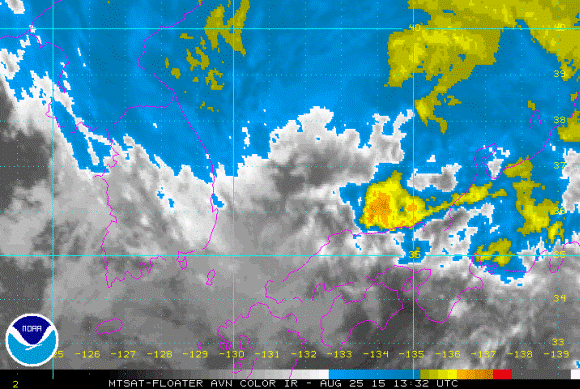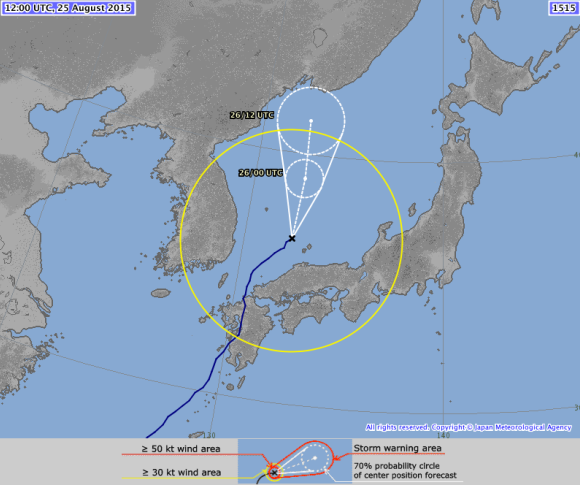Typhoon Goni
Status: Closed
| Type of posting | Posting date(EST): | Summary | Downloads |
|---|---|---|---|
| Landfall | 8/25/2015 12:30:00 PM |
|
|
| Pre-Landfall 1 | 8/24/2015 2:30:00 PM |
|
Landfall | Summary
Posting Date: August 25, 2015, 12:30:00 PM
Typhoon Goni Weakens and Pulls Away from Japan
Typhoon Goni made landfall in Kumamoto Prefecture on the island of Kyushu at about 6 a.m. Tuesday local time. Reported wind damage includes fallen trees, minor damage to buildings, downed utility poles, and power outages. The heavy rainfall associated with Goni has resulted in flooding and landslides. The now weakened typhoon is expected to dissipate to a remnant low by Thursday local time, and no longer poses a major threat to any landmasses.
Meteorological Conditions
At about 6 a.m. on August 24, Typhoon Goni made landfall near Akune, Japan, with maximum 10-minute sustained winds of approximately 176 km/hr. Goni began to weaken as it tracked generally northward to north-northeastward through the Yatushiro Sea and then Shimabara Bay to the west of Kumamoto, Japan, before emerging into the southern end of the Sea of Japan near Fukuoka.
According to the Japan Meteorological Agency (JMA), Typhoon Goni was located at 36.5oN, 132.3oE as of 12:00 UTC, August 25, 2015, with a central pressure of 980 mb and maximum 10-minute sustained wind speeds of 90 km/hr. As of 13:32 UTC, Goni had already lost most of its tropical characteristics, with a highly asymmetric cloud field and no deep inner core circulation (see Figure 1).
Figure 1. Infrared satellite image of Goni at 13:32 UTC August 25, 2015. (Source: NOAA)
During the 24-hour period ending at 11:00 UTC on August 25, the highest reported rainfall in southern Japan was 667 mm at Odai-Cho Taki-Gun in Mie Prefecture, located more than 500 km to the east of Goni’s track. More typical high rainfall values in southern Japan were in the range of 200 to 300 mm.
Before making landfall on Kyushu, Goni passed through Okinawa Prefecture Sunday night, producing a maximum recorded wind gust of 256 km/hr, according to local reports.
Exposure
Throughout Japan, building codes are stringent and reflect the country’s exposure to both wind and earthquake hazards, but many existing structures predate the existence of these codes. Wood construction dominates residential exposures, and modern wood-frame houses exhibit good lateral resistance to wind loads. However, damage to roof coverings and windows can allow wind-driven rain to enter and cause extensive damage to contents. Furthermore, dislodged external components can become wind-borne debris and cause damage to surrounding structures and glazing.
Larger multi-family apartment buildings and commercial and industrial structures are generally engineered and made of reinforced concrete or steel. Damage is usually confined to nonstructural components, such as mechanical equipment, roofing, cladding, and windows. A significant portion of Japan’s industrial stock is of non-engineered light metal construction, which is one of the construction types most vulnerable to high winds.
Reported Damage
Travel was disrupted as local and international flights were cancelled or delayed, and rail services, including Shinkansen bullet trains, were suspended. Evacuation advisories for more than 100,000 people were issued in northern Kyushu and parts of the main island of Honshu.
Kyushu, like much of Japan, is mountainous, forested terrain, with small, narrow plains along the coast. Due to this topography, rivers are relatively short and have steep gradients. Wind drives most typhoon-related loss in Japan, but flooding is a significant threat because of Japan’s orientation, location, and terrain.
The heavy rainfall associated with Goni has caused flooding and numerous landslides in Kyushu. In addition, reported damage includes fallen trees, and minor damage to building walls and roofs. With utility poles downed, about 455,900 households in Kyushu and 75,000 in Chugoku region were left without power.
Impact to the Insurance Industry
The density of insured exposures is relatively low in Kyushu. In Japan generally, insurance policy conditions for flood can be more complicated than those for wind damage. Flood insurance does not exist as a standalone policy and take-up rates remain relatively low.
Flooding is expected to take its toll on agriculture and rice paddies may be hard hit. Take-up rates for rice insurance are high since it is a compulsory insurance in Japan.
Forecast
Weakening as it propagates generally northeastward and then northward through the Sea of Japan, Typhoon Goni is expected to dissipate to a remnant low by Thursday local time and no longer poses a major threat to any landmasses.
This will be AIR’s final NewsALERT on Goni.

Figure 2. Track forecast for Typhoon Goni, as of 12:00 UTC August 25, 2015. (Source: JMA)